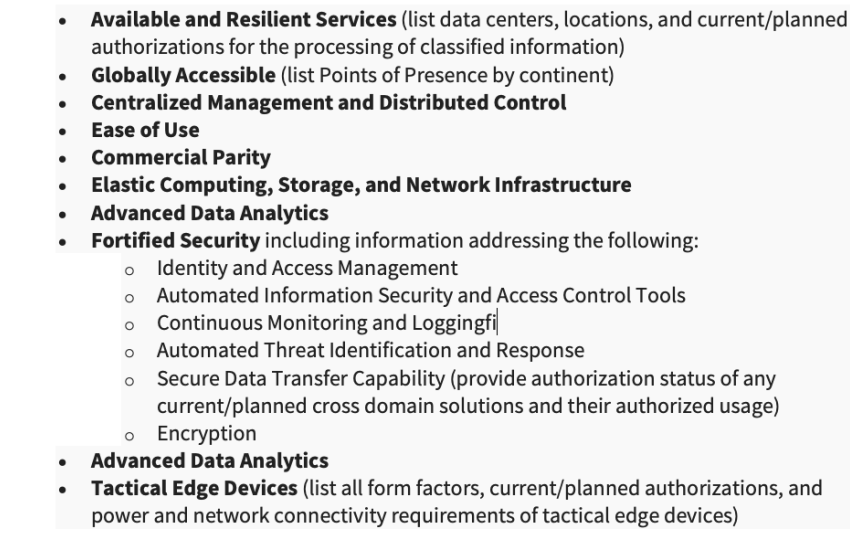DoD Joint Cloud Opens for Warfighters on December 21
After multiple years of delay from a contested award, the Department of Defense (DoD) will finally be able to offer a joint warfighting cloud environment with a range of commercial services and features. The Department announced on December 7 that the so-called JWCC, or Joint Warfighting Cloud Capability, with a $9 billion ceiling was awarded to four companies: Amazon Web Services Inc. of Seattle; Microsoft Corp. of Redmond, Washington; Google Support Services LLC of Reston, Virginia (HQ003423D0017); and Oracle America Inc. of Redwood City, California.
The three-year firm-fixed-price and time-and-materials, indefinite-delivery/indefinite-quantity contract, which includes two possible one-year extensions, will bring state-of-the-art compute, storage and support services to the U.S. Combatant Commands, DoD agencies, the services and other military users.
DoD Chief Information Officer John Sherman; Director of the Defense Information Systems Agency (DISA) Lt. Gen. Robert Skinner, USAF; DoD Deputy Chief Information Officer for the Information Environment Lily Zeleke; and Director of the DISA Hosting and Compute Center (HaCC) Sharon Woods spoke about the JWCC award to reporters at the Pentagon on December 8, noting that unclassified cloud offerings and related support services would be available to warfighters beginning on December 21.
“This is a first-of-its-kind cloud capability contract that allows us to go from strategic to tactical, that allows us to have multivendor, multi-classification and go directly to the cloud service providers,” Gen. Skinner said. “There's nothing there today that enables that.”
In particular, the JWCC will be fundamental to the military’s pursuit of Joint All-Domain Command and Control (JADC2), as well as to its ability to harness artificial intelligence and leverage data.
“This is a huge day for the department and what we can bring to our warfighters, particularly for areas like Joint All-Domain Command and Control or JADC2,” Sherman stated. “We've talked about being able to provide that undergirding of cloud computing that is going to be there for the combatant commands and many others, to be able to have joint warfighters with the capabilities they need. Getting to this award is a culmination of 17 months of really hard work by the joint team here.”

In particular, the JWCC will provide capabilities at classification levels well above unclassified, at secret and top-secret levels. Providing cloud capabilities for high-impact levels, such as IL 6, where the loss of such information would have a severe impact, is a powerful feature not usually available in commercial cloud environments. DoD had specifically asked cloud providers if they could provide such secure cloud environments to meet the military’s unique needs, with services at parity across all classification levels.
And while the November 2021 down select included all four companies—and eliminated IBM Cloud as a potential contender—it was not clear that all four companies could offer cloud services at the top-secret levels. At the time, DoD planned on at least two contract awards. Military officials performed rigorous testing and evaluation to verify the commercial capabilities—a process that extended the solicitation process by about six months, Sherman noted. The leaders were pleased, however, that AWS, Microsoft, Oracle and Google could all provide higher classification-level services.
Classified cloud offerings for secret information on the so-called SIPRNet, or Secret Internet Protocol Router Network, will be available in early February (within 60 days of the contract award), while cloud capabilities supporting top secret, sensitive compartmented information and special access programs will begin in June, 180 days from the contract award, Gen. Skinner said.
The DoD also required JWCC cloud service providers to make military cloud environments accessible on a global basis, including to users at the tactical edge and in denied, degraded, intermittent environments, such as in the Indo-Pacific region.
“Very importantly, [the JWCC] brings us cloud computing in all three security classification levels unclassified, secret and top secret,” Sherman emphasized. “Now we've got other types of clouds here within the department, but none of them do this at all three security classification levels, spanning the entire enterprise from the continental United States, all the way up to what we call the tactical edge, way out, whether it's the western Pacific or Eastern Europe or onboard a ship. And that tactical edge piece is very critical for our warfighters.”
“The threat and the requirements drive us to the things that you're talking about where we're going to have to be joint and integrated, and we can't miss a step or time,” Zeleke stated. “So really, what JWCC buys us is speed, scale and security, in order to be able to do something like zero trust. This is it. We are going to have to have the diversity of cloud capabilities and the providers and the technology as it evolves.”
HaCC is managing the JWCC effort and has already set up an initial CAC login platform for users. The center is preparing a manual to assist interested parties. Woods explained that organizations can go through their contract authorities or through the HaCC to submit cloud needs. The website also includes a space for users to ask HaCC questions about the JWCC.
Groups will submit cloud task order mission requirements, on which the cloud service providers will bid. All four vendors will be provided an opportunity to compete for the task orders, “which means they need to be competitive for those requirements,” Woods specified. This type of multivendor service and capability bidding environment will ensure competition is central to the provision of cloud services. And the companies are each only guaranteed $100,000.
“It's a shared ceiling of $90 million,” Gen. Skinner explained. “Each of the vendors is guaranteed $100,000 as part of the contract. For the task awards, we don't have a certain number of task awards because it's all based on the number of mission requirements that our mission partners have.”
“We've been working really hard to be innovative in our task order competition process,” Woods noted. “There is flexibility within the acquisition process to, for instance, use that automation tool to put together the package itself. And as part of that process too, DISA is positioned to provide advice and guidance, as we become more familiar with what that process looks like.”
Having the military be able to directly approach the cloud service providers through the task order process—instead of going through third-party distributors—is also a powerful feature, the officials noted.
“The other thing I'd offer is [that] we have a great relationship with the CSPs [cloud service providers],” Gen. Skinner shared. “And so, as we work together, we will figure out innovative ways to make sure that the speed of need is there for our warfighters.”






Comments